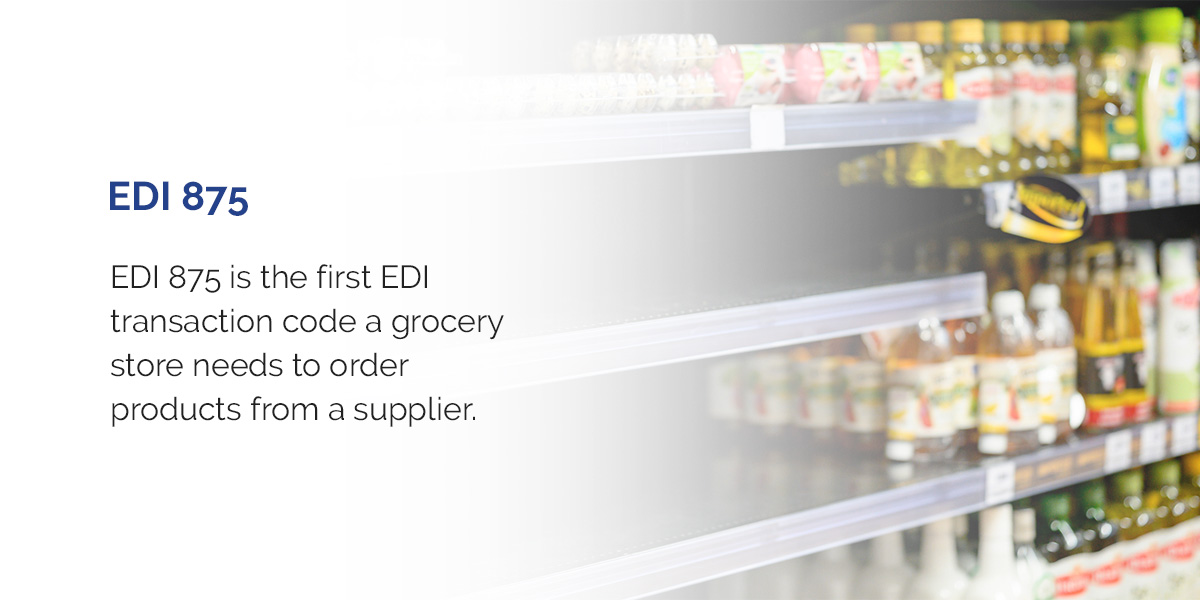Grocery Store EDI Transaction Codes: A Guide

February 15, 2023
Grocery stores need to send and receive large quantities of business data, from order details to invoices to shipping information. Manually entering all this data into a computer system is inefficient and prone to errors, which is why many grocery stores and retailers use Electronic Data Interchange (EDI) to automate document sharing. EDI streamlines transaction processing and increases productivity for faster order fulfillment.
Transaction codes are an essential part of EDI. Each EDI transaction code corresponds to a specific business document needed to take an order from placement to delivery. When a grocery store exchanges EDI transaction codes with a supply chain partner, the partner’s EDI system translates the transaction codes’ components to interpret their meaning. In this guide, you’ll learn about the importance of EDI transaction codes along with the most common grocery store EDI codes and their components.
The Importance of EDI Transaction Codes
EDI documents, called transaction sets, include data elements like company name, order quantity, item number, and price. The consistency, order, and format of a transaction set’s data elements are essential for ensuring the document is transmitted accurately.
Recognized standards define these data elements and provide a common language through which EDI solutions can communicate. In the United States, the American National Standards Institute (ANSI) sets the standard for EDI communication. Over 300,000 global companies use ANSI EDI transaction codes. Many require their trading partners to be EDI capable, meaning that understanding EDI transaction codes is crucial to business growth.
Looking for More Information on EDI Transaction Codes?
Grocery Store EDI Codes
As a grocery retailer, you’ll likely see a few EDI transaction codes more than others. Here are some of the most common grocery store EDI codes and their components:
EDI 875
An EDI 875 document is also called a Grocery Products Purchase Order. Grocers usually transmit an EDI 875 to a wholesaler, manufacturer, or another supplier to order items to stock their shelves. The recipient of the EDI document determines whether it can fill the order and responds with an EDI 855 Purchase Order Acknowledgement. If the supplier doesn’t have the correct quantity of items, it might respond with a purchase order change or reject the order.
EDI 875 is the first EDI transaction code a grocery store needs to order products from a supplier. Grocery stores typically send this transaction code after reviewing new products from a catalog or discussing with the supplier or vendor about carrying the product. EDI 875 is simpler than an EDI 850 Purchase Order, which is used for a broader range of products that might be more technical.
An EDI 875 contains crucial information for helping the manufacturer or supplier pick the right items for the grocery store. EDI 875 includes the following details:
- Purchase order number
- Buyer and supplier identifying and contact information
- Date of order
- Buyer billing and shipping details
- Product identifying information such as SKUs or UPCs
- Product quantity
- Unit price and total order cost
- Other special shipping instructions, such as preferred carrier
- The requested delivery date
- Proposed payment terms
EDI 876
EDI 876 is specifically for grocery stores and other grocery product retailers. EDI 876 is also known as a Grocery Products Purchase Order Change because this document specifies any changes the buyer needs to make to a previously-sent purchase order. Once the supplier receives an EDI 876, they confirm the change by transmitting an EDI 997 Functional Agreement.
EDI 876 documents alert suppliers that grocery stores need a different quantity of an item than they previously thought. For example, a grocery store manager might realize that a particular item is selling more quickly than they expected and wants to replenish inventory quickly. Grocery stores may also need to remove products they no longer need from an order. EDI 876 is the solution to both of these needs. Grocery stores can send an EDI 876 at any point in the transaction process, but earlier is better, so the supplier has time to make the adjustments.
EDI 876 must specify what changes the grocery store wants to make to the existing purchase order. Product quantity changes are specified with an updated quantity rather than the difference between the previous order quantity. To delete an item, a grocery store uses a quantity of zero.
Here is the information contained in an EDI 876:
- The original purchase order number
- Supplier and buyer identification and contact information
- Product identifiers for changed products
- Product quantity updates
- Resulting price changes
EDI 880
Also known as a Grocery Products Invoice, EDI 880 is one of the most commonly used grocery store EDI codes. Suppliers like food and beverage manufacturers send an EDI 880 to grocery stores to bill them for their purchases after product shipments have been delivered. The receiving grocery stores match the EDI 880 to the related EDI 875 to ensure the transaction’s details are correct and schedule payment. EDI 880 is useful for invoicing grocery stores because it provides a traceable and efficient method of tracking transactions.
EDI 880 makes invoice tracking and payment easier for both parties involved. Suppliers can streamline the invoicing process by automating EDI 880 documents. If grocery stores can affirm that the document’s information is correct via integrated EDI, they can eliminate significant manual data entry for the transaction. Both trading partners will also have a record of the EDI 880 in their integrated accounts payable or receivable systems.
This EDI transaction code must convey several important details of the grocery products sale, including the item quantity and the total amount due. EDI 880 documents typically contain the following information:
- Buyer and supplier identifying information
- Shipping and billing addresses
- Remit-to information
- Quantities, descriptions, and prices of products in the shipment
- Total amount due, including discounts, extra charges, or adjustments
- Payment terms
- Taxable amounts
EDI 882
The last EDI code frequently used in the grocery industry is EDI 882, known as a Direct-Store-Delivery Information document. Grocery suppliers like producers, manufacturers and wholesalers use this EDI transaction code to affirm that a shipment of goods has arrived at a grocery store’s location. EDI 882 is a summary that tells the grocery store about the product delivery and any adjustments the supplier had to make.
Suppliers use EDI 882 when they send a shipment directly to the store instead of to a warehouse distribution center. This supply chain strategy can reduce lead times, making it ideal for perishable food items that grocery stores must put on the shelves quickly. After grocers receive an EDI 882 document, they usually respond with an acknowledgment and might immediately send a payment for the order.
EDI 882 focuses on the delivery of a particular shipment rather than specific product information. Although EDI 882 includes the payment due for the order, it is not an invoice. This EDI transaction code contains data like:
- Supplier number
- Ship-to and from addresses
- Delivery summary
- Any returns or adjustments
- Total amount due
- Request for payment
Streamline the Grocery Supply Chain with EDI
EDI transaction codes enable strong connections between trading partners along the grocery supply chain. Using EDI speeds up communication and reduces errors in document exchange to streamline transaction processing. Through automation, partners gain critical insight into every step of the supply chain and are empowered to make more informed decisions to increase supply chain efficiency.
When your business needs an EDI solution, partner with TrueCommerce. We provide EDI solutions and fully managed EDI services that are easy to use and compatible with your tech stack and have more than two decades of experience in the grocery space. Our cloud-based EDI solutions connect retailers with a global network of trading partners and 24/7 support.
If you need assistance optimizing your grocery store’s use of EDI to streamline your supply chain, contact an EDI specialist at TrueCommerce.
Share this post:
Categories
Stay ahead of the competition
Get expert supply chain insights delivered directly to your inbox weekly.

